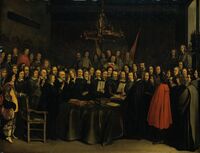| History of Dundorf | |||||||
|---|---|---|---|---|---|---|---|
| SETTLEMENT ERA | |||||||
| Early History BC 1000 - AD 801 | |||||||
| The First Confederation Era AD 802 - AD 1278 | |||||||
| The Autocratic Era 1279 - 1720 | |||||||
| The Second Confederation Era 1735 - 1813 | |||||||
| NATIONAL DEVELOPMENT | |||||||
| Unification and Constitutional Monarchy 1813 - 1922 | |||||||
| The Reign of Kaiser Wilhelm I | |||||||
| [[]] | |||||||
| [[]] | |||||||
| [[]] c. 1000 - 1831 | |||||||
| [[]] 1832 - 2080 | |||||||
| [[]] 2080-2086 | |||||||
| MODERN NATION | |||||||
| [[]] 2086-2134 | |||||||
| [[]] 2134-2166 | |||||||
| [[]] 2166-2174 | |||||||
| [[]] 2174-2181 | |||||||
| [[]] 1912–1949 |
The history of Dundorf is closely linked with several other countries in central and northern Artania and is closely linked with the history of Artania itself.
Early history (1000 BC to 800 AD)[]
The Dundorfian Empire was not always a singular entity, though modern historians often associate it with a singular entity it went through many periods. Dundorf around BC 1000 through AD 800 began as a period of warring tribes underneath the singular name of the Durvin. These tribes developed individually but would come to develop a strong, decentralized civilization throughout central and northern Artania. The Durvin tribe began to spread from central Artania, now modern Dundorf. The Durvin originally existed somewhere near the base of modern Dorvik and eventually migrated south when the Tokundian people, who are ancestral descendants of modern Deltarians settled in modern Dundorf. Historians often debate the movements of the Durvin people as they were heavily decentralized and little remains of these incredibly war-like people
Between 600 and 400 BC the modern Dundorfian region of Zackerland (now Grozvic) is believed to be the greatest extent of the Tokundians, it is believed in this area that the two cultures intermixed socially and culturally with several modern Dundorfian folk cultural activities borrowed from this apparent meeting. Linguists believe that the mixture of these two cultures created the hybrid language known as Dunedurven (believed to be named after an ancient ethnic Dundorfian village of the same name), which is the direct ancestor of modern Dundorfian. As the Tokundians began their migrations towards Majatra, some Dundorfians went with them. This continual migration is believed to have driven the Dundorfians further south to the areas of the area now known as Ichredön. It is believed that around 320 BC the Dundorfians, with newly founded Tokundian weapons, the Dundorfians began raiding into Kirlawa, Rutania as well as limited success in what would eventually become Kundrati.
After the Tokundian migrations the Durvin tribes remained relatively at peace when it came to external relations with other "nations". The Durvin tribes continued to war with each other for the next couple of centuries, with the areas of Southern Dundorf and Ikradon becoming incredibly rich due to their warmer climate. Many of the Dundorfian tribes would go on to settle in their respective lands and warred with each other. Ecological historians suggest that the population of the Durvin tribes grew at a faster rate between 200 BC and 200 AD because of the climate warmed up in central and northern parts of Artania, leading to a growth of crops and increase in population. Those who settled in the central and northern portion of Artania often went south to join Dundorfian raider groups that would raid the fertile and trade-rich Ichredön, which had been settled as a blending of Tokundians and Dundorfians. The language that developed due to the Tokundian and Dundorfian settlement in Ichredön would go on to be a linguistic anomaly but remain an incredibly important language throughout the history of the world. The period of raiding would be known as Feunodden (Old Ichredöne: "North Fire"; believed to derive from direction of and the torching of buildings by the raiders) was a known period of raiding against the rich southern portion of Artania.
By 800 AD the Dundorfian raiders had overrun the modern region of Ichredön and had married, killed and bought their way into the highest ranks of Ikradonian social and political power. While the northern portion of Artania remained in a state of war with petty kingdoms and Dundorfic fiefdoms sprouting up and being destroyed, the Ichredönian enjoyed success due to the Gulf of Ikradon and trade with newer nations and nation-states that began to sprout up over the unknown world to the Dundorfians. One of the major developments of this time was the adaptation of Apostolic Hosianism which would have a lasting future effect on the entire world.
First Confederation (802 to 1278)[]

Der Kaiserlicher Kurfürsten-Rat (Imperial Elector Council) representing all Hochadel or High Nobles of the kingdom
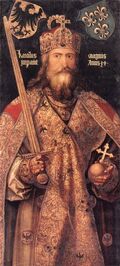
First King of Dundorf: Manfred II von Eschenbach, Großherzog von Zackerland, König von Dundorf und Ichredön (r. 1059-1064)
As the Durvin tribes began to mesh and assimilate with each other the adaptation of the modern Dundorfian language became commonplace. Many of the regional languages and what is known as proto-Dundorfian began to die off. During this period the development of what would become known as the Uradel' or "Old Nobility would be formed underneath the banners of many prominent Dundorfian families, several of them being: von Eschenbach, von Kahr and von Burchardinger and dozens of others. The concept of landownership became divided between Principalities, Duchies and Countries and several Dundorfian-specific ownerships such as Margraves. The Durvin tribes, to distinguish themselves from the Ikradonians who had become their enemies, began to call themselves the Dundorfians from the name of the land that they settled.
One of the main adaptations that the Ichredönians had provided to the Dundorfian was the concept of government and centralization, thus the first Confederation of Nobility was formed. This confederation was the first semi unified Dundorfian government who helped oversee the management of new lands added to their growing empire as well as oversee lands currently owned by them. This adaption from the Ichredönians would lead to the nobles of the growing Dundorfian Confederation to form the first Dundorfian Reich, the term is often translated by historians as "Empire" but more accurately is translated to as "realm". The Dundorfians, despite being centralized held a very strong cultural bond with each other and this promoted a very early form of nationalism within the Dundorfian tribes. While they often quarreled with each other when an external enemy appeared they would often unite against them briefly before returning to their respective in fighting.
This first confederation was lead by the Kaiserlicher Kurfursten Rat (Dundorfian: Imperial Elector Council) which at this time rarely met, it represented all of the Hochadel (High nobles or the upper tier nobles or uradel). This "Imperial Elector Council" met infrequently but still maintained incredibly power within the first confederation with the responsibility of electing the head of the Dundorfian Reich, the King of Dundorf and Ikradon (Dundorfian: Konig von Dundorf und Ichredön). The Imperial Elector Council was summoned by the Apostolic Archbishop of Oderveld, who was considered to be the most senior Dundorfian bishop to the Holy Apostolic Church. The Archbishop had to summon the council within one month of the King's death and had to meet within three months to choose a successor.
Manfred II von Eschenbach, the Grand Duke of Zackerland was elected as the first King of Dundorf and Ikradon (r. 1059 to 1064). The first King held little power but he was a unifying figure in the history of the Reich, he organized defense of the Reich, was responsible to represent the Reich to foreigners and helped to resolve disputes within the kingdom. Though the King had been a "central" figure the concept of feudalism reigned supreme and local autonomy was paramount on most matters of society and state, even with the advent of the confederation the local nobility never revealed their previous powers.
Ichredön, though dominated by Dundorfian nobles was rebellious. The Ichredönian did not take well to the Dundorfians ruling and taking a portion of their trade with foreign nations. In 1267 underneath Ikradonian "King" Ikradonous III he invaded the Duchy of Gildark, however the "King" was met by Count (Graf) Gerhard Joseph von Wittelsbach and was defeated; von Wittelsbach was awarded with the title of Grand Duke and his lands moved up to the status of Grand Duchy by King Hans Otto II von Burchardinger, Prince of Rheinbach (r. 1260 - 1275). This was not the first time in 1272 King Ikradonous III returned after a period of exile and at Felsen a fortress of the Ritterdundorfischer battled Count Peter Sebastian von Rommel, von Rommel was defeated and forced the Dundorfian and Ikradonians to sit down and come up with a peace accord.
Though the peace accord saw many ethnic Dundorfians leave Ichredön, it also saw the fall of the House of Burchardinger as King Hans Otto III was killed in a rearguard action at the river Ode, a major river running through Ikradon into the Gulf of Ikradon. Though the loss of the King dealt a serious blow to the House of Burchardinger, they retained their position as Uradel. With the Felsen Treaty signed in 1274 the Dundorfian Reich took a serious look internally. Many Dundorfian nobles believed that the Ikradonians would not honor the treaty and try to usurp the position of Dundorfian Emperor and the nobles firmly believed that they needed more leadership from the Imperial Elector Council and the new King.
In 1278 the King and the Imperial Elector Council called a Grand Council (Dundorfian: Großen Rat) of all men of noble birth from throughout the kingdom. The new council met in November and decided to take steps to alleviate their situation. Despite opposition the nobles voted to give up most of their autonomy to a centralized authority in the King and the Imperial Elector Council.
Autocratic Era (1279 to 1720)[]
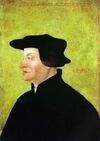
Gert van Tassel
In the period of 1279 through the early 1500s the King and the Imperial Elector Council ruled with varying degrees of power, at times they were able to be highly centralized and other times they fought a losing battle to the same decentralization that they had won years early. The gradual shift was towards loosening centralization. This period however was one of stability, cultural and economic growth for a majority of the peoples living underneath the Dundorfian Reich; major cities experienced a massive revival and renewal of interests in humanity, culture and overall quality of life. Rural Dundorf remained the same but slowly these ideals would spread throughout the entire empire. University towns such as Chonstaat-am-Bingen (Rabstein), Haldor (Kordusia), Unterschloss (Oderveld) and Volzhaus (Rheinbach) developed with the help of the Apostolic Church, this had increased the prestige and wealth of the Kingdom overall.
The period of stability and economic growth was shattered when a Markerbürger, Ikradon-born merchant named Gert von Tossel (Duntrekker: van Tassel) and his family returned from Luthori preaching a new faith: Amelioratism, a branch of Abjurantism. John Martyn, a Dundorfian-born priest of the Apostolic Church had already began his efforts to reform the Apostolic Church in the early 16th century but as these had failed he went to the Holy Luthori Empire to attempt to garner support for his ideas. His failure to reform the church prompted his "Fifteen Abjurations against the Apostolic Church" which began the formations of Abjurantism, notably the Confessional branch of Abjurantism in 1519. van Tassel returned to Dundorf's Markerburg, known today as Dunlake, and spread his new teachings in the agriculturally oriented areas of the land. van Tassel hailed from Nordenhaus and it was home to a small portion of wealthy merchants, van Tassel being one of them.
van Tassel was in Luthori on an eight-year assignment starting in 1518 for the High Merchant Guild of Nordenhaus (Dundorfian: Hohe Handelszünft von Nordenhaus). van Tassel as well as other merchant social circles within Luthori is believed to have been baptized in this new faith of Confessionalism. While keeping up with his merchant duties in the latter part of his stay, van Tassel studied at a seminary and became an ordained minister. Upon the completion of his assignment in Luthori he and his family returned back to Markerburg where he quickly gained converts and started the first Ameliorate church in the small village of Treptow, an entirely new branch of Abjurantism.
It was not soon after these converts quickly became pariahs to the majority of Apostolic noblemen and burgers throughout Dundorf. Religious discrimination, both official and unofficial befell many smaller communities of Ameliorates and were soon termed as Duntrekkers or "Dunners" by adherents. It was because of this discrimination and persecution that Duntrekkers soon came together in small communities for protection, often collecting on lands of lower nobles (Dundorfian: Niedere Adlige) who had converted. It was within these small communities, largely isolated from the rest of Dundorfian society, that the foundation of modern Duntrekker culture and language developed. Duntrekker culture and language was heavily influenced form van Tassel's Ikradonian background.
Tolerance and persecution[]
In 1529 Gerhard I von Wittelsbach was elected as King Gerhard I and brought a new wave of tolerance towards the Duntrekkers (Dundorfian: Dunnischen). The King passed the "Confessing Laws" (Dundorfian: Verbesserung Gesetze) of 1530 which pressured local nobles to allow Duntrekkers to worship freely under conditions that they do not attempt to further convert Apostolic subjects. In 1532 both Duntrekker nobles and peasants were given permanent lands in Markerburg (Dunlake) and encouraged, sometimes violently to migrate to them.
In 1534 the death of Gerhard I ended the period of tolerance for the Duntrekkers. Trade, movement restrictions, forced conversations and general persecution by local nobles and lords quickly followed the coronation of Hardol von Eschenbach, the Grand Duke of Zackerland, as King Hardol I. It was shortly after that the Great Pogrom (Dundorfian: Großes Pogrom) occurred towards the Duntrekkers throughout Dundorf. On Triumph Day, 1537 fueled by false rumors of ritual murder and sexual perversion the Apostolic subjects of Markerburg raided several autonomous communities of Duntrekkers by looting and destroying property. The violence however spiraled out of control and it was documents by sources that 2,434 Duntrekkers were killed, notably tortured to death and an estimated 200 Duntrekker women, both young and old, were raped. The early histories of this era often cite that local nobles were directly responsible for the ordering of the progrom but more recent studies have leaned towards members of the Apostolic church while the nobles turned a blind eye towards the violence and persecution.
Smaller and more isolated pogroms and acts of violence continued throughout the 16th century but gradually became less and less common as more and more peasantry began to convert to Amelioratism or Confessionalism, the other branch of Abjurantism founded in 1519 directly by Martyn Luthor. By 1610 is it believed that half of Dundorf's peasantry had converted to either Ameliorate Hosianism or Confessionalism. Modern studies have given a slanted view of the two branches of Abjurantism with some studies putting nearly 90% of the peasantry following the Ameliorate beliefs compared to the Confessional beliefs. Regions such as Markerburg (Dunlake), Oderveld (sometimes written as Oderfeld) and Julstoch (also known as Rheinbach) gained the most converts while Rabstein remained the most staunchly Apostolic.
Greater conversion[]
Independent conversion progressed steadily throughout the 17th century and was aided in 1655 by the foundation of the Royal Hosian Seminary (Dundorfian: Königliches Hosiliches Priesterseminar). It was at this time that the largely Apostolic nobles began to convert, largely to Ameliorate Hosianism but some had began to follow the Independent Confessional branch of the religion. The most notable conversion was Count Helmuth von Hohenstauffen in 1698. The conversion of the Hohenstauffen family, a powerful and influential family in the royal court, prompted many other "Uradel" (Luthorian: High nobility) and lesser nobles to convert. Church documents show that roughly two-thirds of all nobles in the kingdom were Ameliorate Hosians, the remaining being Independent Confessional or remaining Apostolic Hosians.
The Apostolic's in the nation faced eradication by conversion. The Apostolics and the remaining Apostolic nobles struck back in January, 1700 in what would become known as the "Second Great Pogrom" (Dundorfian: Zweites großes Pogorom). The wave of violence by Apostolics hit the Duntrekker communities hard than others as they tended to be isolated and more secrective compared to other Ameliorates or Independent Confessionals. Modern sources believe that the deaths reached at least 6,000 but some documents cite higher numbers such as 15,000 to 25,000. The Second Great Pogrom is considered paramount as it believed to be the cause of Die Groot Trek (Duntrekker: The Great Trek), or a migration of thousands of Duntrekker families out of Dundorf to various corners of the world including Saridan, Likatonia, Pontesi and Malivia. This is how "Dunners" became the modern ethnic group known as the Duntrekker people.
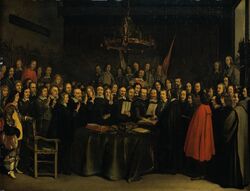
The Kaiserlicher Kurfürsten-Rat of 1720 voting the monarchy, and themselves, out of existence. Notice the black, plain clothes worn by the Electors demonstrating the heavy influence of Amelioratism in Dundorf. Painting by Johann Schumann, 1724.
Despite the violent reaction of many Apostolic followers by 1718 roughly 88% of the population had been baptized in the Abjurantism faith. Sources of the era are difficult due to the violence associated with the conversions but historians believe roughly 79% of the population were Ameilorate while the remaining had been Independent Confessional.
Collapse of the Autocratic Era[]
The abundance of noble conversions to Amelioratism and Independent Confessionalism had prompted a strong emphasis on localism and the power of the King had been in steady decline. By 1718 most nobles had simply retreated to their own lands, effectively ignoring the political and social power that was allegedly wielded by the autocratic Kings. It took two years of summoning by in 1720 the Elector's Council met, only to eliminate the monarchy and then proceeded to vote itself out of existence in less than a days time.
TO BE NAMED ERA(1720 to 1735)[]
WTF HAPPENED HERE?!?!?
Second Confederation Era (1735 to 1813)[]
The Elector's Council meeting in 1720 is sometimes attributed as "dissolving" the monarchy and thus the Kingdom of Dundorf but in reality the Elector's Council decided not to elect a new King of Dundorf. For 15 years several prominent members of the Elector's Council sat as "Realm Regents" (Dundorfian: Reichsregent). It has been noted here before but it should be noted again that in modern era many Luthorian speakers take the term "Reich" to mean "Imperial" but in the Dundorfian language the term means "Realm". At this time the Dundorfian polity is considered to be a "Kingdom" (Dundorfian: Königreich) but known as the "Dundorfisches Reich" or the "Dundorfian Realm".
It was only a decade later that the Elector's Council began to realize that the decentralization was hampering Dundorf's development and petty wars were breaking out amongst the lands of the kingdom. The development of new technologies, the competition with the Holy Luthori Empire, the reliance on more raw materials (such as iron, copper and coal), the manufacturing of durable trade goods (furniture, clocks, etc.) and the trade of cereal grains (barley, wheat and potatoes) forced the economy of Dundorf to be more important.
United Customs Union[]
In 1731 the United Guild of Merchants (Dundorfian: Vereinigte Gilde der Kaufleute) met in Bergengruber, Oderveld to create a common internal customs system. The United Guild of Merchants was made up of various merchant guilds, prominent business magnates and the powerful middle class of Dundorf. The various polities of Dundorf were hampering the trade between merchants and businessmen of the very fractured nation. This ad hoc guild formed the United Customs Union (Dundorfian: Vereinigte Zollunion) to regulate trade and bring the economies of various states and polities together. This customs union, while it appeared to be popular with merchants, townspeople and the independent farmers soon began to attract the negative attention of the feudal, rural nobles who felt it was jeopardizing their sovereignty and wealth. This attention was spread by these rural nobles through word of mouth and by 1732 the rural nobles had officially organized against the customs union.
A rift formed between the so-called "City Nobles" (Dundorfian: Bürgerschaft or Adlige der Stadt) and the "Rural Nobles" (Dundorfian: Rittergüter or Landadlige) over the customs union. A proposal was brought forth by the members of the von Klings, who represented the city nobles and members of thevon Hohenstauffen, who represented the rural nobles. The proposal was to create an "Elder Court" (Dundorfian: Älteres Gericht) to decide the issue. The United Customs Union was taken to court and remained on "trial" for nearly for a year before it was decided by the court that the efforts of the customs union held greater benefits, both financially and culturally, for all nobles and commoners, than the current system of local sovereignty.
The verdict of the Elder Court was imposed on all nobility and this was a period of expansive growth for cities and towns as their markets and capital began to explode with wealth. This was a large-scale shift in financial focus from land to capital, rural to urban and was a slow process towards the eventual change in political power. The rise of "Bürgers" began slow and eventually became a rapid movement towards political integration for the Kingdom of Dundorf. Many farsighted city nobles began to forsee that even further political unification was in the not so distant future. By 1734 nobles had drawn sides, largely based on urban and rural lines and began the long process of debate and negotiation for a new system of governance.
Second Grand Council[]
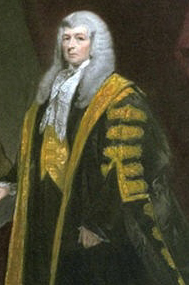
Kaiser Hosian I (r. 1736-1766). Painting by Marcus Koyt circa 1754.
The following year in 1735 a second Grand Council (Dundorfian: Großer Rat) was called for the first time since 1278. The council met for the same reason as the previous one: the formation of a stronger kingdom (often referred to in the time period as a confederation) and the election of a new King of Dundorf. In a break from the old confederation that last for several centuries, the nobles of this Grand Council decided to develop and reform institutions. The Grand Council formed the Imperial Diet (Dundorfian: Kaiserliche Landtag) and was meant to replace the Imperial Elector Council as a whole.
The Imperial Diet was much more institutional in nature, it only allowed nobles owning property or money equaling 5,000 gold florins (roughly equating to 500,000 Dunmarks) to vote and run in designated provinces. The Council met annually for several months a year and further worked towards creating a unified economy and law system. The new monarch was given the "Kaiser of the Dundorian Reich" or "Dundorfian Kaiser" but served as a figurehead much similar to the previous "King of Dundorf" (sometimes referred to still as "King of Dundorf and Ikradon"). On January 1st, 1736 the first Kaiser was elected; Friedrich Wilhelm II von Klings, Prince of Rheinbach was crowned as Hosian I, Dundorfian Kaiser.
From the election of the first Kaiser in 1736 until 1813 the Imperial Diet presided over an overwhelming series of rapid economic and cultural changes, not only within the "Dundorfian Reich" but the world as well. The various merchant, artisan and professional occupations began to expand all over the reich and grew more powerful given their wealth and status within the rapidly growing urban populations. As this new class of Dundorfians expanded, a new divide grew between the traditional nobles and the new "nobles of wealth" (Dundorfian: Adlige des Reichtums) over taxation, representation in the diet and ultimately political power.
Despite the attempts at centralization Dundorf struggled to be a unified nation-state. It remained largely decentralized with potent "vassals" such as the Kingdom of Dorvik, the Kingdom of Kruthia, the Kingdom of Aloria and others exercises near total control over their lands and other groups competing for political power. The Kaiser and the Imperial Diet had very little real means of enforcing the law, this largely fell to the "vassals" of the Kaiser and the new Dundorfian Reich. The von Klings continued to produce several more Kaisers but ruled in Dundorf and less over Dundorf until the pivotal year of 1813 when the ideas of unification, centralization and Dundorfian nationalism became an unstoppable force throughout Dundorf.
Unification Era (1813 to 1922)[]
In 1813 a series of pamphlets were published preaching the new ideas of Nationalism, notably Dundorfian nationalism. The ideals of nationalism would soon excite both the commoners and elite within Dundorf. The most famous and profound pamphlet was the "Rise of the Dundorfian Nation" (Dundorfian: Steigen von der Dundorfischer Nation) by Klaus Bernhoff, a profession of philosophy at Oderveld University. In this pamphlet Bernoff spoke of the need to define a new nation dedicated to ethnic homogeneity and ultimately democracy based up ethnicity. Bernhoff did not however specify nor define the ethnic characters of this new Dundorfian nation. Regardless of its faults, the pamphlet sold over a half million copies and sparked fierce debates in all circles regarding unification.
In 1817 Franz Wagener, an ethnic Dundorfian university student in modern Kirlawa published his pamphlet "The Pan-Dundorfianism Movement" (Dundorfian: Der Alldundorfischer Bewegung) that strict definitions of the Dundorfian ethnicity and culture were determined. Franz Wagener wrote: "We want to protect the eternal foundation of our life: our national identity and its inherent strengths and values ... Farmers, burghers, and workers must once and for all become one Dundorfian people." The pamphlet outlined a movement of unification underneath the current Kaiser, who would no longer be subject to election but would gain hereditary status while the powers of the Imperial Diet would be increased to that of a national parliament elected by universal suffrage determined by manhood and those defined as ethnically Dundorfian. This pamphlet and his further works Wagener became Dundorfians most prolific nationalist author and many considered him to be the "Father of Modern Dundorf".
Wagener's ideas became popular and were taught in all classes of Dundorfian society. Workers, peasants and wealthy merchants enjoyed the emphasis on universal, ethnic, male suffrage in the election of a national parliament. Nobles, while not keen on giving up their power, they were keen on the prominence that would be brought with a central monarch and future power implications of an Imperial court. It appears from modern historical study that all classes enjoyed the concept of belonging and Dundorfian exceptionalism that were being taught by Wagener's teachings. Despite all these teachings Wagener did not address the question of irredentism of ethnic Dundorfians who were largely in the minority of Dundorfian Reich holdings such as Rutania, Kirlawa and partially in somewhat even Aloria. The issue of Dundorfian nationalism and Dundorfian irredentism would plague the future Dundorfian nation-state.
Unification[]

Friedrich Wilhelm IV, Prince of Oderveld from the Haus von Hohenstauffen; the "Father of Dundorf" and leader of the unification movement ADV.

Kaiser Hosian IV (r. 1819-1834). Portrait by Leopold Gustav Fleischmann circa 1830.
Across the Dundorfian lands the masses were interested in the new concept of nationalism and a new movement was formed with emphasis towards unification of all Dundorfians into a new nation-state. The movement was closely based on the ideas expressed in Wagener's works and in 1820 was titled the "Pan-Dundorfian Movement" (Dundorfian: Der Alldundorfischer Verband; ADV) after Wagener's first and prolific writing.
The head of the newly created ADV was future Kaiser Wilhelm I (Friedrich Wilhelm von Hohenstauffen), the Prince of Oderveld from the House of Hohenstauffen. Friedrich Wilhelm was able to mediate, with the help of other members, in the organization quest for unification of all ethnic Dundorfian lands. The ADV eventually became the largest informal faction within the Imperial Diet and was able to put significant political and even economic pressure on the various Kaisers that would live through this era. Friedrich Wilhelm became such a popular figure inside and outside of the nobility that he became the de facto symbol of Dundorfian ethnic unity.
The power of the ADV continued to grow within governments various autonomous states of Dundorf as well as the Imperial Diet and the concept of unification became much more of a reality compared to a concept. On June 8th, 1831, nearly 14 years to the day of the publication of Wagener's "The Pan-Dundorfian Movement" pamphlet that sparked the national interest in unification, the unification was put to a national audience. While the ADV was the most powerful faction supporting unification, there were forces opposed to it. Archduke Anton von Duisberg (Archduke Anton IX) and Grand Duke of Chontalonia opposed the unification process. Imperial Diet procedure was archaic and traditional and it required a near unanimous "nine-tenths" vote of in-session members to support any all-encompassing legislation.
For two weeks in the heat of June the Diet debated the idea of unification. Large nationalistic, pro-unification marches were carried out in all major cities and the autonomous states of the Dundorfian Reich and were sponsored by the ADV. Newspapers carried their own debates as proponents and detractors tried to persuade the handful of undecided members of the public to support their positions. The break in debate came on June 21st, 1831 when several non-Diet members of the ADV broke into the pre-session meeting of the Archduke's faction and subsequently locked four of the anti-unification members, including the Archduke himself, in the chamber until nearly noon before being overpowered and arrested by the Diet's own police force.
The absence of the Archduke and his supporters gave the ADV members in the Imperial Diet the chance that they had been waiting for and the Prince of Oderveld himself stood up to voice the call for another vote on the measure around 10:30am. The Diet subsequently voted but it was not until roughly 11:45am that the were tallied: the result was the necessary numbers to pass the legislation. The normally reserved and proper traditions of the Imperial Diet were disregarded as loud celebration turned into the singing of the nationalistic anthem Heil dir im Siegerkranz(Luthorian: "Hail to Thee in Victor's Crown") which was pro-unification.
As a matter of tradition the legislation was brought before Kaiser Hosian VI who, understanding the gravity of the situation, agreed and signed the legislation at 4:12pm. The stroke of the Kaiser's pen had made the concept of unification into a reality.
Constitutional Assembly[]
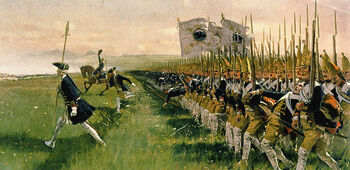
Reichsheer forces training. Painting by Sebastien Berger, 1850.
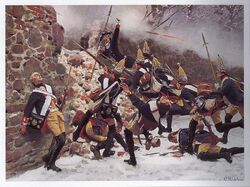
Members of the 1. Oderveld "Kaisers Own" Grenadier Regiment storming the fortress at Sudschloss-am-der-Czimnetz in Grozvic. Painting by Sebastien Berger, 1848.
As news of the unification spread throughout Dundorf and the autonomous Dundorfian states, the country celebrated with feasts, traditional dances and music. June 21st, 1831 became known as "Unification Day" and is still celebrated today as a commemoration of both the event and the wider culture of the Dundorfian people. As the celebrations died down the Died proposed the election of a "Constitutional Assembly" (Dundorfian: Verfassungsmäßige Versammlung) to create a new constitution for the nation. The composition of the Constitutional Assembly's deputies would be a mixture of appointed and elected members.
The Imperial Diet agreed that the newly empowered Kaiser would one-third of the deputies with approved of the Imperial Diet, the nobles of Dundorf would elected from within themselves another one-third of the deputies and the final third would elected by the "common people", which was limited to those non-nobles who fit the property and monetary criteria.
It was agreed that the newly empowered Kaiser would appoint one-third of the deputies with the approval of the Diet. The nobles of Dundorf would elect from themselves another third of the delegates while the final third would be elected by the common people; common people of course referring to non-noblemen fulfilling the property qualifications. The assembly would finally meet in February of 1832 to write the new constitution and would quickly become plagued by several problems.
Several prominent high and low nobles, lead by Grand Duke Anton IX refused to accept the legitimacy or jurisdiction of any constitution created and were actively forming an army in the County of Grozvic. In addition to the threat of civil war and conflict, questions arose over the size of the nation. Should all autonomous states and territories of the Dundorfian Reich be included in the central government? Should they become independent states? Vassals?
Breakup Crisis[]
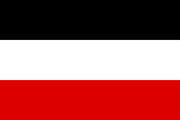
First flag of the unifed Dundorfischer Reich. The Kaiser Fahne (Kaiser Flag).
The first piece of legislation decided upon by the Constitutional Assembly and with the consent of the Kaiser was the formation of a permanent, unified army. The Reichsheer (Luthorian: Realm Army/Imperial Army) to enforce governmental authority over the newly declared "breakaway" polities. The conflict would become known as the Trennungskrise (Luthorian: Breakaway Crisis). As the assembly debated and argued over the constitution, the financing was gained from wealthy merchants and nobles for the new Reichsheer. The new 10,000 force began in training underneath the command of Kurt Augustus von Rommel. It was during training that the new national flag, the Kaiserfahne (Luthorian: Kaiser Flag), was unfurled for the first time and served as an inspiration for the new national army to fight under.
The Reichsheer quickly moved against the army of Duisburg and the other breakaway nobles. The armies engaged in battle outside of Sudschloss-am-der-Czimnetz in Grozvic. The battle that ensued was short and bloody for both sides but it was clear that the new Reichsheer had emerged victorious. The breaching of the ancient walls defending the city allowed the 1. Oderveld "Kaiser's Own" Grenadier Regiment to breach the city and take the city. It took several months following the Battle of Sudschloss-am-der-Czimnetz for the remaining breakaway nobles to capitulate, either by force or surrender. It was during the end of the "Breakaway Crisis" that the so-called "Kaiser Constitution" (Dundorfian: Kaiser Verfassung) was created on August 20th, 1834.
The Kaiser Constitution[]
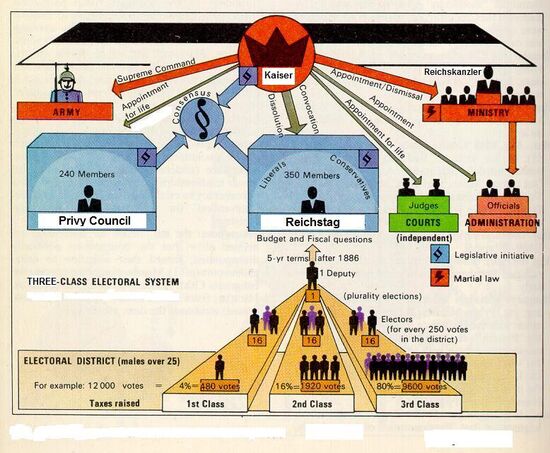
Graphic of the Kaiser Verfassung (Kaiser Constitution) of 1834.
The new "Kaiser Constitution" had a number of authorities and powers granted directly to the Kaiser, they included: the Kaiser being a hereditary position, appointment of ministers and a personal Privy Council (Dundorfian: Geheimer Rat) for advisory purpose, represent the Dundorfian people at home and abroad, conclude treaties with the approval of the new Reichstag, declare war with the approval of the new Reichstag, serving as the Commander-in-Chief of the Reichsheer, the appointment of the General Staff, the appointment of ministers of the government, the authority to veto or approve budgets and legislation, the power to call for the election of a new Reichstag.
The "Imperial Diet", now entitled as the "Reichstag", would become the national parliament of the Dundorfian Reich, it would be presided over by the Reich Chancellor (Dundorfian: Reichskanzler) it would have the authority to propose budgets and legislation, it would have equal representation of all "major" states and would be elected by the "three class suffrage" system. The three class suffrage system ensured that the nobles always came out ahead and won a majority of power within the Reichstag.
The Kaiser Constitution also established the Imperial Court (Dundorfian: Reichsgerichtshof), a unified court system through the entire nation, it would settle issues between all states and be responsible for any trials of national government officials. While many were supportive of the Kaiser Constitution, there were some that felt that the Kaiser had been given too much power and the so-called "Kaiser Crisis" (Dundorfian: Kaiserkrise) had started.
Kaiser Crisis[]
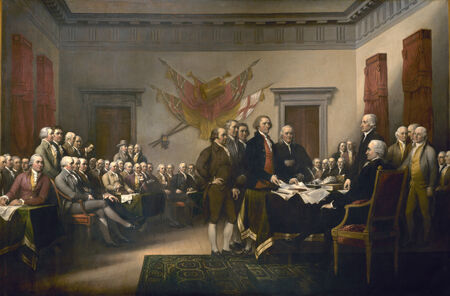
This painting captures the moment after Graf Johannes von Rommel (center) nominated Fürst Friedrich Wilhelm IV von Hohenstauffen in absentia as candidate for Kaiser, much to the surprise of Friedrich Wilhelm. Painting by Johannes Bauer, 1836.
As many deputies of the Constitutional Assembly felt that the Kaiser was given too much power, the reigning Kaiser, Hosian VI, a known closeted autocrat believed that he had been given enough power. He notably did not like the Reichstag's authority over the budgets, treaties and war. Kaiser Hosian VI rejected the constitution outright, much to the displeasure of the assembly and the nation. On September 3rd, 1834 Kaiser Hosian Vi presented himself before the assembly to explain himself to the naysayers by giving a near two-hour speech on the rights and power he, as a monarch with the "Divine Right" (Dundorfian: Gottesgnadentum) should be given
However, many Assembly deputies felt the Kaiser was given too much power under this constitution. Ironically, the current Kaiser Hosian VI, a known closet-autocrat, believed he was not given enough power; he especially did not like the Reichstag's power over his office concerining budgets, treaties and war. So Kaiser Hosian VI rejected the constitution out of hand, much to the displeasure of the Assembly and the nation, sparking what would come to be known as the Kaiser Krise (Kaiser Crisis). On 3 September 1834 Hosian VI presented himself before the Assembly to explain himself to his naysayers by giving a near-two hour speech on the rights and powers he, as a monarch with Gottesgnadentum (Divine right), should have been given:
Following the speech the assembly murmured quietly until Friedrich Wilhelm von Hohenstauffen, Prince of Oderveld stood and spoke. Friedrich Wilhelm was widely respected by both liberal and conservative assembly members. He was well known for his conservative and royalist stance but his lawyer training and oratorical skills was put to use. Friedrich Wilhelm was above all a staunch supporter of the rights of the nobility. Friedrich Wilhelm having listened intention to the Kaiser noticed the illegality of his words. Friedrich Wilhelm would soon utter words that would be well known throughout Dundorf and world history and turn him into a legendary figure within Dundorfian history, Friedrich Wilhelm stated to the Kaiser:
«It may be that the Kaiser reigns over Dundorf, my dear sir, but the Reichstag rules it.»
|
The implications of the state was most easily defined by historian Gertrude Steiner as "...the legislature has always written the rules while the monarch has always sat there". The assembly instantly understood the implications of Friedrich Wilhelm's statement. Kaiser Hosian VI, embarrassed and at a loss for action, offered his abdication as a threat to the assembly the next day. Much to the Kaiser's surprise, the assembly had seen itself as the de facto government accepted the Kaiser's abdication and Hosian VI went down as the last of von Klings and abdicated in disgrace.
On September 10th, 1834 the Constitutional Assembly acting outside of its jurisdiction decided to elect the 63 year old Friedrich Wilhelm as the first "Dundorfian Kaiser" of the constitutional era. Friedrich Wilhelm was crowned as His Imperial Majesty, the Dundorfian Kaiser, Wilhelm I on September 15th, 1834.
Reign of Kaiser Wilhelm I[]
The year 1834 was a watershed moment for Dundorf. It saw great political, social, and economic change. It was also the witness to the ascendency of one of the greatest figures in Terran history: the new Kaiser Wilhelm I.
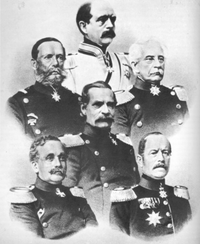
Pcitures of Kaiser Wilhelm I and his Privy Council taken. This image was seen by millions in a school children's civics textbook.
Friedrich Wilhelm IV, Prince of Oderveld from the Haus von Hohenstauffen had begun his career as a junior member of the Kaiserliche Landtag who gained more prestige from his family name than what many believed he would ever gain from his actions. Friedrich Wilhelm ran a law firm between sessions of the Imperial Diet, a rather un-gentlemanly pursuit for a noble "man of leisure".
However, upon reading "Der Alldundorfischer Verband" ("The Pan-Dundorfian Movement") by Franz Wagener he became enthralled by nationalism and exited by the thought of Dundorfian unification. In 1823 Friedrich Wilhelm was invited to a meeting by a fellow Diet-member of a nationalist organization and was soon made its legal counsel. With the purpose of unification in his mind and the backing of the organization Friedrich Wilhelm slowly began to rise within the ranks of the Imperial Diet by taking on more tasks and presenting numerous pieces of legislation.
Simultaneously with this rise in the hierarchy of the Imperial Diet came the ascension to the leadership of the nationalist organization which Friedrich Wilhelm quickly renamed the Alldundorfischer Verband (The Pan-Dundorfian Movement) or ADV. Friedrich Wilhelm represented this organization in the Imperial Diet. He was the head of the organization when unification came to full fruitation and his popularity and prestige only grew during the subsequent Kaiser Crisis. The corridors of power echoed with the question as to who would be the new Kaiser after the abdication of Hosian VI.
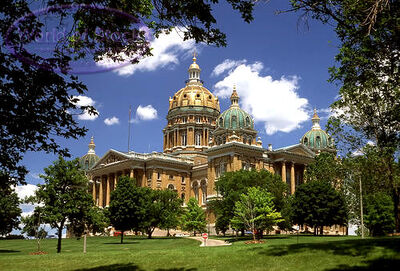
The new Reichstag building constructed during the reign of Kaiser Wilhelm I. The land was donated to the Kaiser personally by an organization of landlords in Dunburg. The government had to displace a whole slum neighborhood, tear down their tenaments and create an artificial hill in which to place the building. The Kaiser himself oversaw construction and recommended to the contractors to give construction jobs to displaced families of the tenements.
Friedrich Wilhelm soon stood alone as the only viable candidate, given his popularity both with the nobility and commoners.
The Reign of Kaisers Wilhelm II & Augustus I[]
Badarenprotektorat[]
In 1882, Dundorf founded the Badara Protectorate. The Sultan of Al'Badara acted as a puppet of Dundorf's government. This protectorate effectively collapsed in 1928, during Dundorf's civil war.
The Augustan Era[]
=The Reign of Augustus II[]
Characteristics of the Age[]
Society & Class[]
- odd time between new concept of class and older, more rigid concept
- most of the period,
The Arts & Culture[]
- most famous literature, plays, operas, etc
- music grew; classical music, new symphonies, new types of music experimented; battle for "soul" of music in this era
- Dundorf became a nation of art & musical patronage
- Romantic & emotional paintings created
- paintings became infused with nationalism; large complaint that "Dundorfians made art for Dundorfians"
Economic Changes[]
- further growth of industry
- cities grew rapidly, grew into much more importance
Politics[]
- dominated by the conservative Traditionelle Konservative Partei Dundorf (Traditional Conservative Party - TKPD), the liberal conservative Liberal-Konservativen Partei (LKP), and the Independent Confessional Bewegung der Hosiengemeinschaft (Movement of the Hosian Community - BCG)
- witnessed the emergence of socialism as political force; trade union movement grows
- class struggle emerged politically with creation of the socialist Sozialrevolutionären Partei (Social Revolutionary Party) & the Partei der Institutionellen Revolution (Institutional Revolutionary Party)
- debate within the movement as to whether engage in violence of gradual changing of politics towards socialism
The Reign of Kaiser Georg Wilhelm & the First Dundorfian Civil War[]
In the 1920s, First Dundorfian Civil War broke out in Dundorf between Socialists and Capitalists.
- socialists become aggressive, promoting militant trade unionism
- enact reforms; government biased towards right, unions begin taking own control, no "rule of law"
- capitalists/conservatives/monarchists/military/ rise in revolt
- Kaiser stays neutral, unable to kill subjects
- revolt put down after two years
Modern History[]
In the early 21st century, Dundorf was home to Kalistan's exiled House Ananto.
Dundorf hosted Dorvik's Sir James Chisem during his period in exile between 2038 and 2043.
In 2166, the International Greens held their conference in Dundorf. In 2183, the Dundorf Sovereignty Coalition was created for the purpose of ending the economic war against Dundorf.
Bareminstan Excursion[]
In 2262, Dundorf sent troops to Barmenistan to aid the Insurgent Tendency in their attempts at Aotearoan independence. They withdrew in 2270 after a major military defeat.
In 2312, Adolph Dinkel of Dundorf was co-awarded the first Hero of Terra prize(with Lord Timothy Bunton of Dorvik) "[f]or founding and spearheading peace talks between the nations of Dorvik and Dundorf". This ended the hostile relations between the two nations that had been ongoing for a number of years.
During the 2320s, several Stalinist organizations, such as the KED, allowed the Deltarians to invade Dundorf. However, a staunch Right-Wing and moderate Left-Wing opposition never allowed the Deltarians to get the complete control (see Deltarian political invasion of Dundorf ). To this day, the Right-Wing never trusts the Left-Wing, especially becaue of the Right-Wing rule in the 2360s.
2330s Crisis[]
Starting in the 2330s, Dundorf gave aid to the Popular Militia led by Colonel 'X', the leftist forces in the Kirlawan Civil War. In March of 2335, Dundorf officially entered the war against the Fascist forces. After peace talks, Dundorf sponsored the nascent Democratic Republic of Kirlawa, the most leftist of the four nations making up divided Kirlawa. Many Dundorfian fighters fought for the DRK during both the first and second Kirlawan Civil Wars, in the 2330s and 2360s.
In 2335, the Senate building in Fairfax, Dorvik, burned down. Dundorfian interests were initally blamed, but this was never proven. Also in 2335, Dundorfian elements were accused of supporting six Socialist-linked bombings in Kundrati, famously detailed in the Spoletto Report.
In the late 2330s, rightist elements in Dundorf accused some DCMLU parties of being funded by Dundorf's socialists; these accusations led to the arrest and conviction of Green Freedom Party leader Tekno Kratt in 2339.
Dundorf is thought to be the original location of the Dundorfian bird flu, which hit parts of Dorvik hard during the early 2360s.
In the mid 2360s, Dundorf was invaded by Rutania, who briefly unseated the Communist government. The invasion was a catalyst to the Second Dundorfian Civil War
In 2428 Dundorf was proclaimed a Kingdom with the crowning of Kovács Márton as König. König Márton's rule lasted 25 years until the election of 2453 saw a return to the republic.
In 2495 The First Church of Dundorf was established as the State Religion of Dundorf.
Early 2606 Constitutional crisis over government over Cabinet positions.
Third Dundorfian Civil War[]
On February 10, 2752 a radical right-wing militia in Julstoch bombed and attacked the Julstochan state capital building. The militia, known as the Dundorf Kapitalist Bund (DKB), used the surprise from these attacks to take over all the major poulation centers in Julstoch. The ensuring civil war would cost Dundorf greatly.
Crisis of the 3000s[]
- Late 3020s & early 3030s, Dundorf experienced a quick transition of parties into & out of the government, as well as many temporary and fleeting constitutional changes
- period of turmoil & insecurity
- economy suffered; government was grossly ineffective
- paramilitary groups created to support local communities; loss of governmental control; violence erupted throughout the nation; population continued to grow via refugees, immigrants, illegal immigrants, etc
- seedy elements, organized crime, etc poured into the nation; causing increased crime rates & lack of stability
- some small towns taken over by armed groups; almost feudal-like states
- without effective leadership and facing mounting economic & monetary crises, members of the ministry of finance printed money, thus causing hyperinflation & continuing to fuel the economic crises
- due tp inflation & the inability to effectively collect funds, the government was unable to pay for services, especially unemployment insurance and merely cut off payment to those effected; therefore causing further confrontation with people
Socialist era[]
The Dundorfian Democratic Republic had its origins in the 2500s when socialist parties within Dundorf begun to dominate the political spectrum. Over the ensuing centuries, the new republic experienced ongoing political unrest as governing socialist forces encountered resistance from conservative political and societal factions keen to return to the previous liberal order.
The DDR disintegrated as an entity in the early 3000s, thanks to an unprecedented political crisis among the governing socialist factions. The republic was refounded on 10 February 3134, after the formation of the Communist Party of Dundorf from existing left-wing political entities. The CPD sought to restore the country's previous socialist order, and was supported in those objectives by the Republican Socialist Party (Republikanische Sozialistische Partei) and the Dundorfian Socialist Workers Party.
Liberal state[]
The refounded DDR prevailed over the ensuing decades, but increasingly came under threat due to rising societal discontent. Sluggish economic performance combined with increasingly repressive instruments to preserve the socialist state contributed to an environment conducive to political change.
In response, Die Mitte emerged as a rival political entity, promising to restore a liberal state and rebuild a market economy. After the collapse of the socialist Dundorfische Bauernpartei, Die Mitte rose to power with the election of Alexander Müller as premier and Sara Weiß as the chair of the parliament in 3175.
After an initial programme of reforms, Die Mitte moved to refound the state once more. The DDR was formally succeeded by the Bundesrepublik Dundorf in 3190. Weiß was sworn in as the new republic's inaugural president.
However, Die Mitte dissolved itself after a heavy defeat in the national elections in 3196, losing its majority to the centre-right Liberaldemokratische Partei and the socialist Sozialistische Einheitspartei Dundorfs. Together with the monarchist Radikal Kaiserliche Partei, those three parties formed an all-party-coalition.
Political polarisation[]
The SED started a new attempt of turning Dundorf into a socialist state and re-introduced socialist economic policies and anti-religion laws, supported by the RKP and under the protest of the LDP. The neo-socialist laws were immediately repealed by the LDP after it gained an absolute majority in 3200. Together with the newly-founded Konservative Partei, the LDP, led by Jean-Pierre Du Pont and Michelle Ehrenfeld sought to introduce a neoliberal economic reform programme, including large privatisation projects. The capitalist system led to an extraordinary economic boom, but the leftist parties were dissatisifed with the deregulations, because they also signifantly decreased the power of trade unions and the rights of workers.

Jean-Pierre Du Pont (LDP), first conservative Chancellor of the Bundesrepublik Dundorf, used his absolute majority to introduce a capitalist market economy from 3196 to 3202.
The ensuing years were marked by an ongoing tug-of-war between the conservative and socialist blocs. The socialist parties - including the SED, RKP and Sozialistischer Front - initially succeeded in rolling back parts of the conservative reform programme. But poor socialist organisation meant that left-wing majorities in the Bundestag were unable to stop the Konservative Partei and LDP from introducing new policies, not only in the economic area but in the administration of justice and the military. Despite the fact that the socialist bloc generally always had a majority from 3204 to 3217, elections frequently brought narrow results without clear majorities for either bloc, meaning that the political system often remained a mixture of socialist and capitalist policies.
In 3217, the conservatives returned to power with the help of the SF, which renounced its previous left-wing agenda after a heavy electoral defeat. The coalition of the two right-wing parties and the SF, now named Dundorfische Arbeiters Bewegung, then replaced the left-wing government, with the LDP's Larissa Dreyfus installed as the interim Head of Government. The national-liberal coalition was endorsed at the next elections, and the new government - under the chancellorship of Natascha Issen (KP) - began to reverse the policies of the socialist parties, particularly in the areas of economy and defence.
Following the 3221 elections, political instability prevailed. The socialist bloc (SED, RKP, SP) won a majority but could not form a government, leaving the conservatives in power as a minority government. The government managed to ward off the attempts of the leftist parties to re-regulate the economy and other areas. The minority cabinet eventually served for the full term and the conservatives obtained a majority again in the next elections, which was mainly seen as a votum for stability.
Disarray ensued in 3225 when the DAB collapsed, giving the socialists a nominal majority in the Bundestag. The socialists' decision to form a government and pass sweeping reforms without calling new elections was controversial, and the conservatives heavily criticized the new government as illegitimate.
When elections were eventually held in 3226, the conservatives (LDP, KP and the Freikonservative Partei) secured a large parliamentary majority, while the KP's Michael Hanke nearly doubled the socialists' vote in the presidential race. The victory of the right-wing-coalition was accompanied by spontaneous celebrations in the streets of Dundorf. Due to the overwhelming success of the conservative bloc, the elections of 3226have been dubbed "conservative revolution" by political commentators. After their landslide victory, the conservatives formed a new government under Vanessa Tallerand (LDP) as Bundeskanzlerin and immediately started re-introducing free market policies and abolishing anti-religion laws.
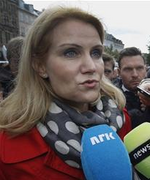
Vanessa Tallerand, Chancellor from 3227-3230, announcing the formation of her government coalition after the conservative landslide victory in 3126
However, the tenure of the conservative government was also marked by a heated discussion over a controversial security bill proposed by the KP that would have significantly extended the powers of the police. The SED and the green-liberal LGB accused Minister for Internal Affairs Elena Neitzert (KP) of intending to establish a totalitarian regime. The fact that the LDP did not support the bill and the FPKD's absence eventually led to the defeat of the initiative. The opposition expressed doubts about the stability of the coalition and Bundeskanzlerin Tallerand was criticized for the poor internal coordination of her cabinet. All these factors led to a rapid decrease of the government's approval rating.
In the next elections, the conservative bloc suffered a heavy defeat, losing both their parliamentary majority and the position of Head of State. After the attempt of LDP, KP, FKPD and the LGB to form a four-party-coalition failed due to the collapse of the FKPD, the left-wing parties took advantage of this and formed a government with the LGB in turn. The free-market system introduced by the conservatives was then partially repealed, as well as some of the vast privatization projects conducted during the conservatives' tenure. The leftist bloc managed to keep its majority in the subsequent elections.
Nationalists ,Socialists and Democrats 3248-4100[]
The Government of Dundorf switched ever so often between Socialist Democratic Republics often known as Dundorfische Demokratische Republik or the DDR, Nationalists who called the nation the Dundorfisches Reich and democrats who called the Nation Bundesrepublik Dundorf.
Right Wing Rule 4100-4228 []
In the late 4000's Dundorf started to move away from its bi-partisan status as more politcal parties satred to emerge as a credible alternative to the Socialist party. This also represented the rise of the right once more and in the early 4100's the first right wing governmnet for many years was founded under Erich Schmidt (TKEPD).
Bundesrepublik Dundorf In Janraury of 4101 the Demokratische Dundorf Republik officially changed its name to Bundesrepublik Dundorf, this marked the start of a new era for Dundorf and its People.
The Reich Chancellor was assisted by the Reich Council (Dundorfian: Reichsrat) which formed a cabinet comprised of nearly a dozen ministries and executive departments. The Reich Chancellor served as the head of the Reich Council, the members of the Reich Council were appointed by the Kaiser and approved by the Reichstag.
The Dundorfian Reich in the passing of Restoration of Dundorfian Heritage and Culture Act and the Organization of the Reich Act in December 4189 the Grand Council of Dundorf was granted authority to return to their noble holdings, however they were not granted the same status as they had during the historical Dundorfian Reich. Instead, the modern 5 regions of Dundorf were preserved and named States of the Reich (Dundorfian: Reichsländer) and are headed by an elected Reichsstatthalter (Luthorian: Reich Lieutenant/State holder). Each of the Reichsländer have a democratically elected Landtag (Luthorian: State diet) which is responsible for regional issues. States of the Reich are further divided in Kreise (Luthorian: County/district) and then either organized into small cities (Dundorfian: Ort) or municipalities (Dundorfian: Gemeinde) or boroughs of major municipalities (Dundorfian: Stadtgemeinde)
The Ministry of the Interior was taken over in 4189 by another Selbstschutzverband officer, Rudi Schürer who immediately launched a massive internal reformation of the ministry. Dundorf lacked a centralized police force and underneath the quick-handed Schürer, the Ministry of the Interior federalized all police forces and began to divide them up. The formation of the Reich Police (Dundorf: Reichspolizei, RiPo) was meant as a means to police the entire Reich, former local units were combined into the forces of the Reich Police. Minister of the Interior Schürer then combined the investigative might of the ministry into the Criminal Police (Dundorfian: Kriminalpolizei, KriPo) which is meant to handle all investigations into a varied of criminal and civil offenses.
The Interior Minister also formed the Secret Reich Police (Dundorfian: Geheime Reichspolizei, GeRePo) which was meant to investigate issues of secret state matters, issues relating to Socialism or Communism and issues related to the Kaiser or constitution. Despite the Luthorian translation of "secret" it did not necessarily mean they were unknown or take extreme measures, it was simply a matter of translation that it translated as such.
One Party State 4228-4243[]
In 4228, the Nationale Traditionelle Partei took over Dundorf leaving it in an era of one party rule. The NTP collapsed in 4235 which led to Leftist Factions seizing power in Dundorf. The Socialistische Einheitspartei (Socialist Unity Party) restored the DDR and reimplemented many socialist policies. This included the nationalisation of the economy.
Two Party Era 4243-4245 []
In the 4243 elections, the Frei Demokratische Partei (Free Democratic Party) won a surprising majority in the then DDR Volkskammer. The FDP was able to repeal many of the Socialist Policies put forward by the SEP but did not have a large enough majority to truly restore the Republic.
Closing Days of the DDR 4245-4251 []
In the 4245 elections, the Konservative Partei (Conservative Party) entered the political scene ending the short lived two party system. In the following elections more parties such as the Dundorfisches Nationalistische Allianz (Dundorfian Nationalist Alliance), Nationale Syndikalistische Liga (National Syndicalist League), Demokratische Partei (Democratic Party), Socialistische Freiheits Partei (Socialist Freedom Party) formed and gradually eroded the Veto Power of the SEP to block constitutional changes. Some of these parties such as the DP disbanded however the majority remained as forces in Dundorfian politics. In the 4251 elections, the SEP had lost its veto power, opening the door to constitutional changes. Shortly after, the SEP collapsed.
The Bundesrepublik 4251-4384[]
Constitutional changes were made to officially end the DDR and establish the Bundesrepublik in its place. The political landscape was dominated by various parties with different ideologies although no major leftist force existed until the Sozialistische Einheitspartei Dundorfs came back to unite the many small leftist Forces.
The years of the DDR 4384-5218[]
In the Parliamentary Election of 4384 the SED went on to win a majority in the National Parliament and reestablish the Dundorfian Democratic Republic. The rule of left wing parties lasted until 4698 when the Dundorfische Volkspartei brought right wing rule back to Dundorf. In 4726 the Militärregierung - Alte Kämpfergruppe overthrew the fascist Schwarye Sonne Gesellschaft and established a military junta ruled by the leader of the army as king. In 4734, the Militärregierung dissolved as stablility had returned to the region, the Libertäre Kommunistische Partei took over and brought democracy and communism back to Dundorf. In the Volkskammer Elections of 4737 for the first time since the restoration of DDR a non-bloc party joined the Volkskammer. With a 6% share of the National Vote the Nationalrevolutionary Party joined the Parliament. Soon after Dundorf became divided again between the left wing forces led by Die Libertäre Kommunistische Partei, and the right wing forces led by the Nationalrevolutionäre Partei. The führer of the Nationalrevolutionäre Partei was killed in 4747, allowing Anton Kreidler to transform the party into the new liberal Liberaldemokratische Union. The current political party holding up the DDR is the Reichssozialist Partei, founded in 5008. Dundorf is now on the verge of civil war due to the recent assassination of the former Königsführer (Leader) Wilhelm Albrecht. The DDR officially ended in March 5218[1], when the new democratically elected government led by Rudolph Rachenhausen of the Vereinigte Bürgerschaft Dundorfs restored the Bundesrepublik.
Restoration of the Bundesrepublik Dundorf (5218-)[]
In 5217, the election to elect the new Government of the Dundorfische Demokratische Republik happened amid institutional uncertainty: the legislative body changed name to "Bundestag", and the official title of the Head of State was "Bundespraesident" (Federal President), indicating a growing Republican, and Federal sentiment among the ruling class as well as the majority of the population. In fact, a year prior to the election, in 5216, a Federal-Democratic Constitutional Reform by the Vereinigte Bürgerschaft Dundorf was passed to end the Monarchist rule, a role held at the time by Oberster Kaiser von Dündorf Wilhelm Theopolis Bötehöven von Oderveld XV, and to establish new democratic institutions.
Rudolph Rachenhausen became the last President of the DDR in July 5217, a few months prior to the end of it, happened in March 5318, when the Nation's Constitutional title was formally changed from "Dundorfische Demokratische Republik" to "Bundesrepublik Dundorf", effectively reflecting the status brought by the reforms happened in the previous two years. From 5218 to 5225, Dundorf has been ruled by an uncontested, ideologically broad party, the VBD, with Rudolph Rachenhausen as Federal President (March 5218 - July 5225), and Margot Fliedermann as Federal Chancellor (March 5218 - August 5225).
In 5225, the first hopes that a multi-party democracy could form over the ashes of centuries of authoritarian rule became true: the July election was contested by three different parties, after the dissolution of the VBD. Members from the left-wing of the VBD, namely Nicholas Bauer, Anselma Boehler and Tom Krupp, formed the Dundorfian Social Democratic Party (Dundorfs Sozialdemokratische Partei), former General Wilhelm von Dransing formed a right-wing party named Dundorfnationale Volkspartei (DNVP), with the scope of 'keeping the Reds out of government' (ndr, the DSDP), while Herbert von Bülow, a former VBD Bundestag member, formed the Hosian-Democratic and center-right Zentrum, later became Bewegung '46. The election saw the dominance of both DSDP (46.5%) and DNVP (42.5%), with the Zentrum sitting at 11%, while General Wilhelm von Dransing became Federal President. A DNVP-Zentrum Coalition Cabinet was later formed, led by DNVP's Bibi Miller.
The right-wing cabinet didn't last long: it was replaced in 5229 after DSDP and a new far-left party, the PdW (Partei des Widerstands), obtained a Bundestag majority, electing also Nicholas Bauer as Federal President, a office he kept until 5235. The election of 5229 is also important in Dundorf's political history as it is seen as the start of the Social-Democratic dominance in Government: a period which saw the DSDP regularly come in first or, albeit rarely, second place in the Bundestag elections, while keeping the office of Head of Government for all that time. The period started in 5229 and ended in 5280, in this period, except 5252-5259, when the PdW held the Chancellery, and in June 5271, there was a Social-Democratic Federal Chancellor. DSDP's political dominance ended instead nine years prior, in 5271, when the Social Democrats came in a third place. In this period, long circa fifty years, DSDP had 6 personalities holding the HoG office: Anselma Boehler, Nicholas Bauer, Carola Gruber, Karlotte Lehmann, Joachim Roth-Schuster and Benjamin Gruenberg. Remarkable is also the re-formation of the NDZP (Neue Dundorfische Zentrumspartei), returned in 5242, which stayed to grow as one of the main center-right parties in Dundorf, and that together with the already mentioned B'46 were able to break DSDP's dominance at least in the Head of State field, defeating high-ranking DSDP personalities such as Tom Krupp and Karlotte Lehmann.
Major breakthroughs happened in the 5270s: the formation of the SZP (Sozialistische Zukunftspartei), later became NZP (Neue Zukunftspartei) and the dissolution of the PdW for what concerns the Left-Wing, the formation of the AfD-V (Alternative fur Dundorf-Vaterland) and of the KBD (Konservative Bundespartei Dundorfs) in the Right-Wing field. The creation and the dissolution of new parties shaked both ends of the political spectrum: SZP gained the role as the dominant left-wing party at DSDP's expense, while AfD-V, later became JA! (Jetzt Anders!), and KBD brought more political diversity in the Bundestag, causing NDZP to lose votes, and later, dissolve. In 5268, years after the dissolution of centrist B'46, a new centrist party formed, the LFPD (Föderalistische Partei Dundorf), which later evolved in the NLP (Neue Liberale Partei), becoming a fundamental piece of Bundestag and Dundorf's politics.
In the 5280s, the formation of the FVP (Freiheitliche Volkspartei) marked the end of long-lasting leftist domination, with the formation of the first center-right and right-wing coalition cabinet, the first being led by Jörg Heissler, of the FVP. The following decades, 80s, 90s, 5300s, mark the alternation in Government of the left-wing, the center and the right-wing, further fueling Dundorf's status as a functioning multi-party democracy. This period knew a insurgency in trade-unions activities, often aided by left-wing parties, to protest bills deemeed to be too right-wing for a traditional left-leaning country like Dundorf.
In the 5300s a new major party formed: the LÖ (Linke Ökologen), Dundorf's first Green party after the GA (Grüne Alternative) existed in the 80s and 90s. Linke Ökologen lived to become one of the most important parties in DUndorf's politics, holding 4 Presidents and 4 Chancellors since its foundation, and with Fritz Schumacher holding the title of second longest serving Chancellor (10 years). In these same years, from 5309 to 5350, the BP (Bierparei), succeeded by the DORF (Dundorfiches Offenes Radikales Forum), playing a role as a centrist party, enabling both left-wing and right-wing cabinets.
The 5320s knew a new succession of center-left cabinets, and the foundation of a new center-right party: the HDD (Hosiandemokraten Dundorfs), previously known as NPD (Nationale Partei Dundorfs), a party that lived to become in the 5350s, 5360s and 5370s, the main center-right party.
As of the 5370s, Dundorf is currently experiencing a rather stable situation aided by the creation of pre-electoral coalitions, the DKU (Dundorf Konservative Union), POD (Progressive und Offene Dundorf) and TL (Team Liberalen), representing each faction in the political spectrum. This situation helped the formation of Dundorf Zuerst! (DZ!), a self-proclaimed anti-liberal, populist party vowing to fight the "uniparty" brought by these new broad coalitions.
Economically, Dundorf knew a period of economic instability and depression after the formation of the BDR, which the Social-Democrat cabinets fought with investments in manifacturing, railways and infrastructure: one example of these plans is the development of a High-Speed Railway System in the 5240s, stimulating economical growth. Dundorf grew steadily until the 5280s-90s, when the economy started to be disrupted by the already mentioned strikes, adding uncertainty to the new political scenarios of the 5280s. In the 5300s growth was rather stagnant, helped by new investments in the mining sector and consequent birth of a tech sector and increased trade and commerce. In this regard, accords with Beiteynu, Dorvik, Luthori, Kundrati and Lourenne helped grow the network of Dundorf's trade.

